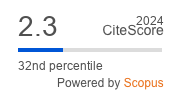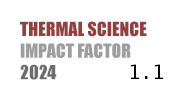ABSTRACT
In this study, three different pipe geometries have been evaluated to investigate the effects of pipe geometry on heat transfer for incompressible flows at different Reynolds numbers. The selected geometries have been determined as dimpled, corrugated, and helical. The study performed threedimensional analyses, and Reynolds numbers were selected as 2000, 3000, 4000, and 5000. The SST k-ω model has been used in the turbulent flow regime, while laminar flow conditions have been analyzed using the appropriate solver settings. The obtained results have been compared using heat transfer coefficient values and skin friction coefficient. The helical pipe demonstrated the highest heat transfer coefficient among all geometries, with a value of 1951 W/m²K at Re = 5000, while the dimpled and corrugated pipes exhibited values of 1910 W/m²K and 1805 W/m²K, respectively. Similarly, the helical pipe showed the lowest skin friction coefficient, with a value of 2.02 at Re = 5000, compared to 2.61 for the corrugated pipe. It has been observed that the heat transfer coefficient and the skin friction coefficient increased with the increase in Reynolds number. The wall temperature distributions on each pipe geometry for laminar and turbulent flow conditions have been obtained and analyzed. When the results were examined, it was determined that the highest heat transfer values were obtained in the helical pipe geometry at all Reynolds numbers, while the highest skin friction coefficient was observed in the corrugated pipe geometry.
KEYWORDS
PAPER SUBMITTED: 2025-01-05
PAPER REVISED: 2025-03-03
PAPER ACCEPTED: 2025-03-04
PUBLISHED ONLINE: 2025-04-05
- Mutschler, R., Rüdisüli, M., Heer, P., Eggimann, S., Benchmarking cooling and heating energy demands considering climate change, population growth and cooling device uptake, Applied Energy, 288 (2021), pp. 116636
- United Nations Environment Programme, 2021. Global Status Report for Buildings and Construction - Towards a Zero Emissions, Efficient and Resilient Buildings and Construction Sector, Report No., United Nations Environment Programme, Nairobi, Kenya, 2021
- Lee, H., Romero, J., Summary for Policymakers. In: Climate Change 2023: Synthesis Report. Contribution of Working Groups I, II and III to the Sixth Assessment Report of the Intergovernmental Panel on Climate Change, IPCC, Geneva, Switzerland, 2023
- International Energy Agency, World Energy Outlook, Paris, France, 2023
- International Energy Agency, Renewables 2023 Analysis and Forecast to 2028, Paris, France, 2024
- Nordin, I., Elofsson, K., Jansson, T., Cost-effective reductions in greenhouse gas emissions: Reducing fuel consumption or replacing fossil fuels with biofuels, Energy Policy, 190 (2024), pp. 114138
- Zhai, H., Gao, S., Zhang, W., Song, Y., Gong, X., Wang, D., Lu, Q., The influence of corrugated pipes parameters on heat transfer characteristics, Thermal Science, 28 (2024), pp. 709-231
- Yadav, A., Mahalik, M. K., Does renewable energy development reduce energy import dependency in emerging economies? Evidence from CS-ARDL and panel causality approach, Energy Economics, 131 (2024), pp. 107356
- Li, G., Zhang, Y., Zhang, G., Huang, S., Tang, Y., Ding, S., Zhou, H., Experimental investigation and numerical prediction on heat transfer performance of a high-speed radially rotating heat pipe, Case Studies in Thermal Engineering, 62 (2024), pp. 105140
- Kishan, R., Singh, D., Sharma, A. K., CFD analysis of heat exchanger models design using Ansys Fluent, International Journal of Mechanical Engineering and Technology, 11 (2020), no. 2, pp. 1-9
- Karuppa Raj, R. T., Kumar, S. M., Mathew, C. A., Elango, T., Numerical analysis of helically coiled heat exchanger using CFD technique, ARPN Journal of Engineering and Applied Sciences, 9 (2014), no. 3, pp. 300-307
- Rabby, M. I. I., Uddin, M. W., Convection heat transfer augmentation inside a hybrid corrugated channel by varying the positions of corrugated configurations, Case Studies in Thermal Engineering, 52 (2023), pp. 103719
- Rabby, M. I. I., Sharif, M. A. R., Hossain, F., Numerical study of laminar convective heat transfer from a corrugated pipe into an Al₂O₃-AlN/H₂O hybrid nanofluid, Case Studies in Thermal Engineering, 39 (2022), pp. 102454
- Dhumal, G. S., Havaldar, S. N., Enhancing heat transfer performance in a double tube heat exchanger: Experimental study with twisted and helical tapes, Case Studies in Thermal Engineering, 51 (2023), pp. 103613
- Al-Obaidi, A. R., Alhamid, J., Investigation of flow pattern, thermohydraulic performance and heat transfer improvement in 3D corrugated circular pipe under varying structure configuration parameters with development of different correlations, International Communications in Heat and Mass Transfer, 126 (2021), pp. 105394
- Virgilio, M., Dedeyne, J. N., Van Geem, K. M., Marin, G. B., Dimples in turbulent pipe flows: Experimental aero-thermal investigation, International Journal of Heat and Mass Transfer, 157 (2020), pp. 119925
- Al-Obaidi, A. R., Alhamid, J., Khalaf, H. A., Effect of different corrugation interruptions parameters on thermohydrodynamic characteristics and heat transfer performance of 3D corrugated tube, Case Studies in Thermal Engineering, 32 (2022), pp. 101879
- Azman, A., Mukhtar, A., Yusoff, M. Z., Gunnasegaran, P., Ching, N. K., Md Yasir, A. S. H., Numerical investigation of flow characteristics and heat transfer efficiency in sawtooth corrugated pipes with Al₂O₃-CuO/water hybrid nanofluid, Results in Physics, 53 (2023), pp. 106974
- Al-Obaidi, A. R., Alhamid, J., Investigation of the effect of various corrugated pipe configurations on thermo-hydraulic flow and enhancement of heat transfer performance with the development of different correlations, International Journal of Thermal Sciences, 176 (2022), pp. 107528
- Al-Haidari, S. R., Mohammed, A., Al-Obaidi, A. R., Analysis of thermal-hydraulic flow and heat transfer augmentation in dimpled tubes based on experimental and CFD investigations, International Journal of Heat and Fluid Flow, 110 (2024), pp. 109604
- Thundil, R., Kumar, S. M., Mathew, C. A., Elango, T., Numerical analysis of helically coiled tube heat exchanger using CFD, ARPN Journal of Engineering and Applied Sciences, 9 (2014), no. 3, pp. 300-307
- Sivasubramaniam, M., Rajan, D. P., Vijayakumar, C. T., Heat transfer and friction factor characteristics of pipe-in-pipe heat exchanger with twisted tape insert, International Journal of Heat and Mass Transfer, 58 (2015), pp. 1639-1648
- Liao, C., Zhou, T., Xu, D., Barnes, R., Bisht, G., Li, Y., Tan, Z., Tesfa, T., Duan, Z., Engwirda, D., Leung, R., Advances in hexagon mesh-based flow direction modeling, Advances in Water Resources, 160 (2022), pp. 104099
- Djordjević, M. Lj., Stefanović, M., Vukić, M., Numerical investigation of heat transfer in spirally coiled corrugated pipes: Assessment of turbulence models, Thermal Science, 28 (2024), pp. 520-184

